(held on February 27, 2019 at 11:00)
The webinar is intended for: designers of lightning protection and earthing
Venue: online (you will need the Internet access on your PC)
Fee: free of charge
Duration: 60 to 90 minutes
1080p full screen watching is recommended.
Webinar text. Page 1
Approximate reading time: 57 minutes.
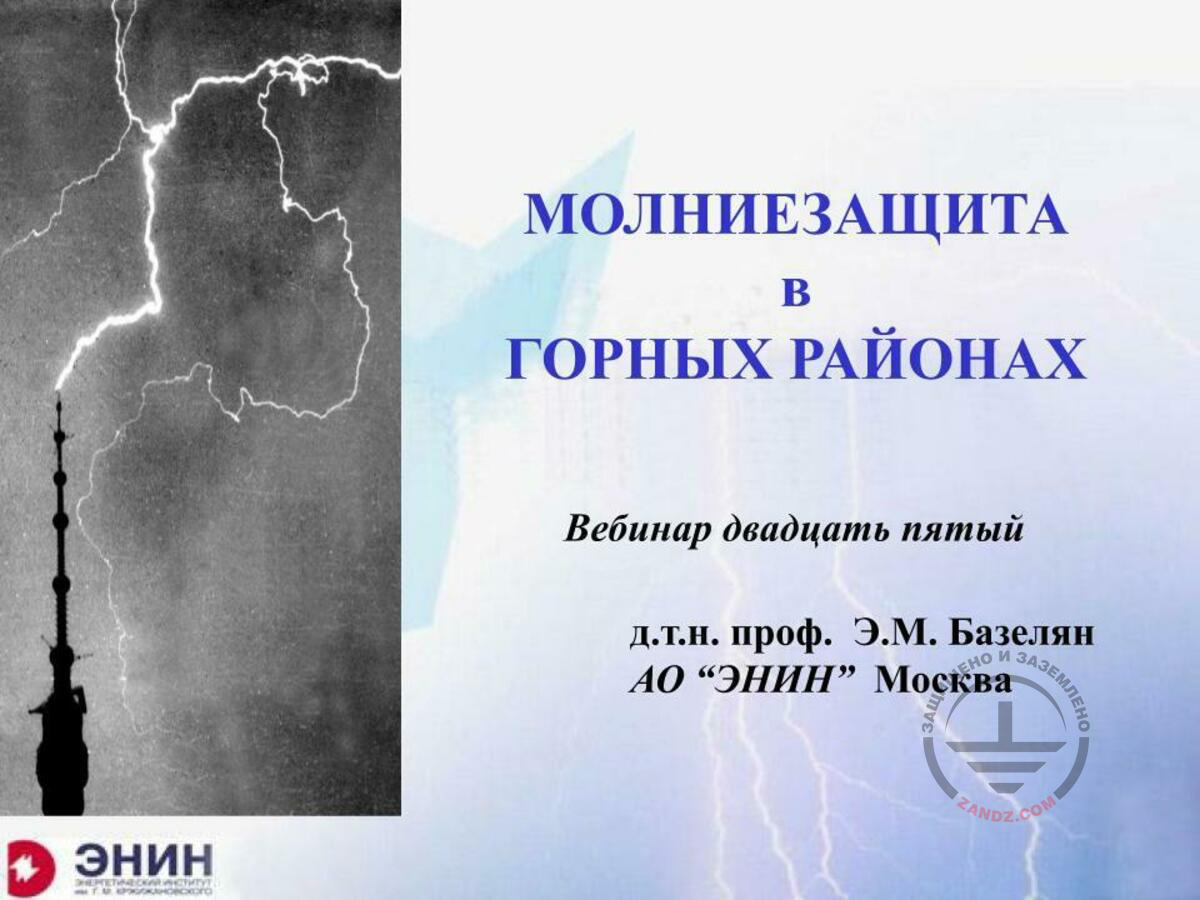
Lightning protection in mountainous areas
МОЛНИЕЗАЩИТА в ГОРНЫХ РАЙОНАХ
Вебинар двадцать пятый
д.т.н. проф. Э.М. Базелян АО “ЭНИН” Москва
LIGHTNING PROTECTION in MOUNTAINOUS AREAS
The twenty-fifth webinar
Dr. Sc. (Eng.), Prof. E.M. Bazelyan, AO “ENIN”, Moscow
– I would like to describe my feelings when I was preparing for this seminar. I had a feeling that I was walking in the shoes of the doctors who teach us, pensioners, to live long and happy. I thought I was in their shoes. And it seemed to me that I would be asked for some miracle pill you need to swallow to live until 100 years old, but I do not know its name and I cannot know because such pill does not exist at all. I was in exactly the same situation when I was trying to study the aspects of lightning protection in the mountainous area. The point is that there is no regulatory standard containing any provisions about the mountainous area. I have a feeling that all our mountains have disappeared, and we have no Crimea, Caucasus and even Altay or the Urals. What can we do?
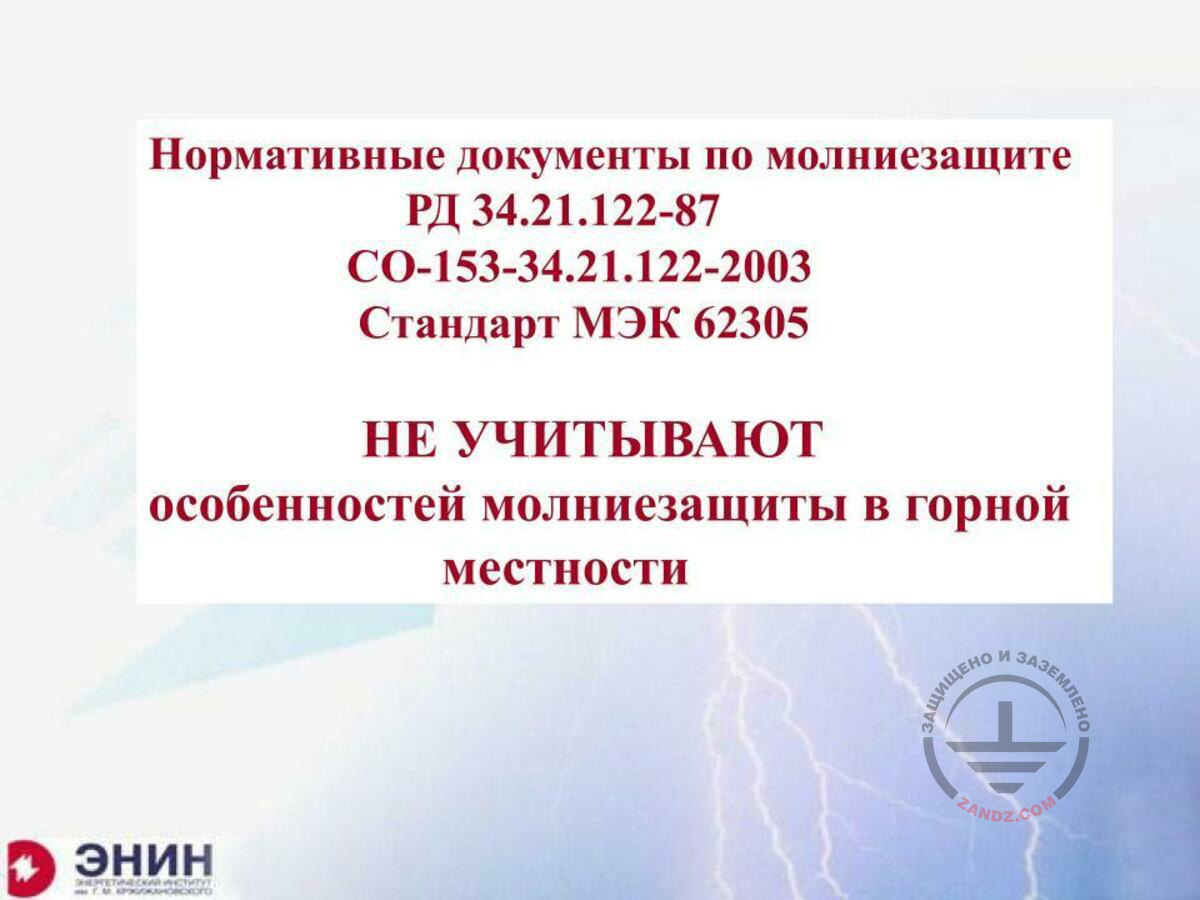
Regulatory documents for lightning protection
Нормативные документы по молниезащите РД 34.21.122-87 СО-153-34.21.122-2003
Стандарт МЭК 62305
НЕ УЧИТЫВАЮТ
особенностей молниезащиты в горной местности
Regulatory documents for lightning protection RD 34.21.122-87
SO-153-34.21.122-2003
IEC 62305 Standard
DO NOT TAKE INTO ACCOUNT
the unique features of providing lightning protection in mountains
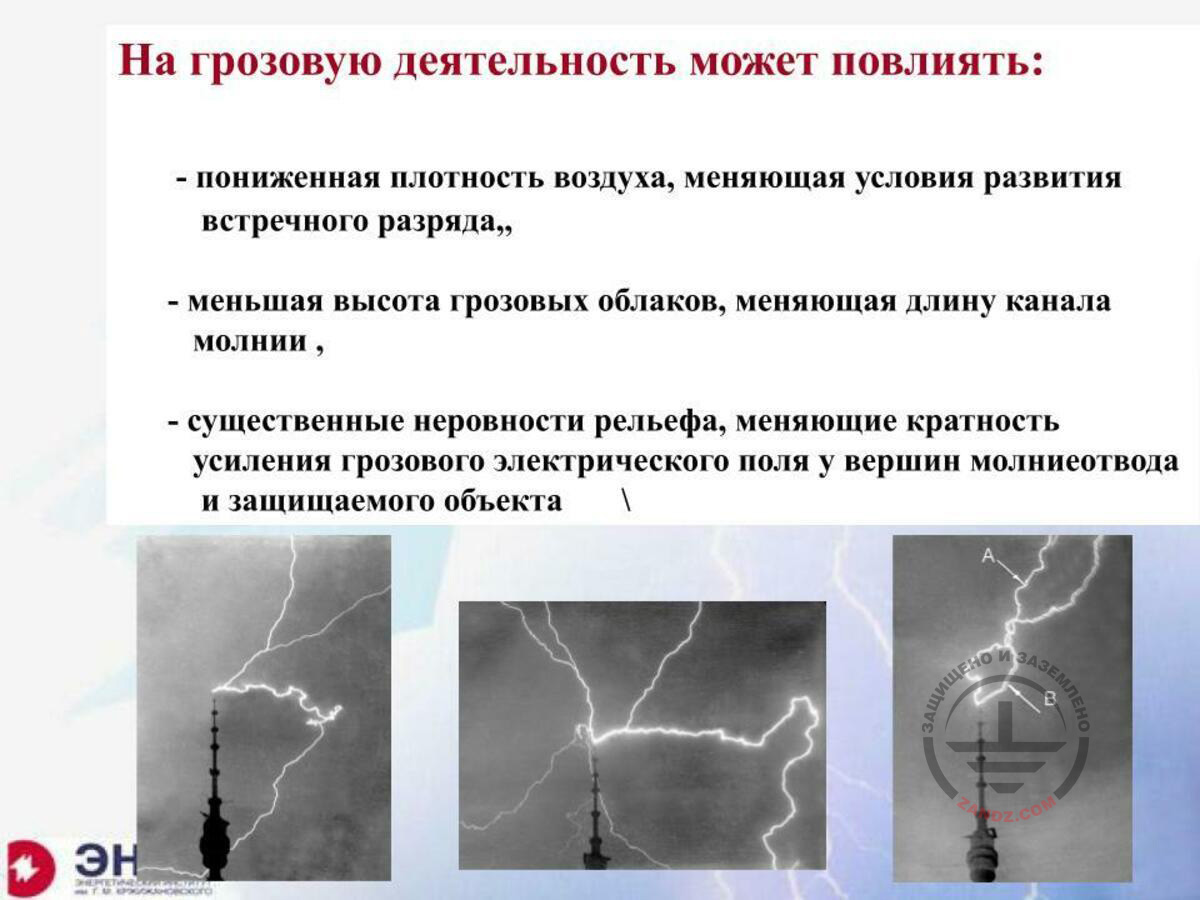
Storm may be influenced by
На грозовую деятельность может повлиять:
- пониженная плотность воздуха, меняющая условия развития встречного разряда,
- меньшая высота грозовых облаков, меняющая длину канала молнии,
- существенные неровности рельефа, меняющие кратность усиления грозовою электрического поля у вершин молниеотвода и защищаемого объекта
Storm may be influenced by:
- reduced air density that changes the conditions of formation of the opposed discharge,
- lower height of thunderclouds changing the lightning channel length,
- significant landscape roughness that changes the amplification factor of the storm electrical field near the tops of the lightning arrester and the protected facility
You know, since I have been studying electrical discharges for all my life, I understand that it must not be like this. It is because the conditions are different in the mountains. And we have to consider at least three important aspects. The first point is that when the height increases above the sea level, the air density changes. If the air density changes, the conditions for the opposed discharges from the tops of the lightning arrester and the protected facility also change, i.e. these opposed discharges determine the lightning strike point. It means that it has to become obvious to some extent. Question is: to what extent? Then, thunderclouds can be formed, e.g., somewhere far away on the plain, and after that they move to the mountains. As a result, the distance from the thundercloud to the facilities on the ground is decreased. The smaller length of the lightning channel must show up some way or another. And this “some way” should be or perhaps should not be taken into account. And finally, the third and the most important aspect is the landscape.
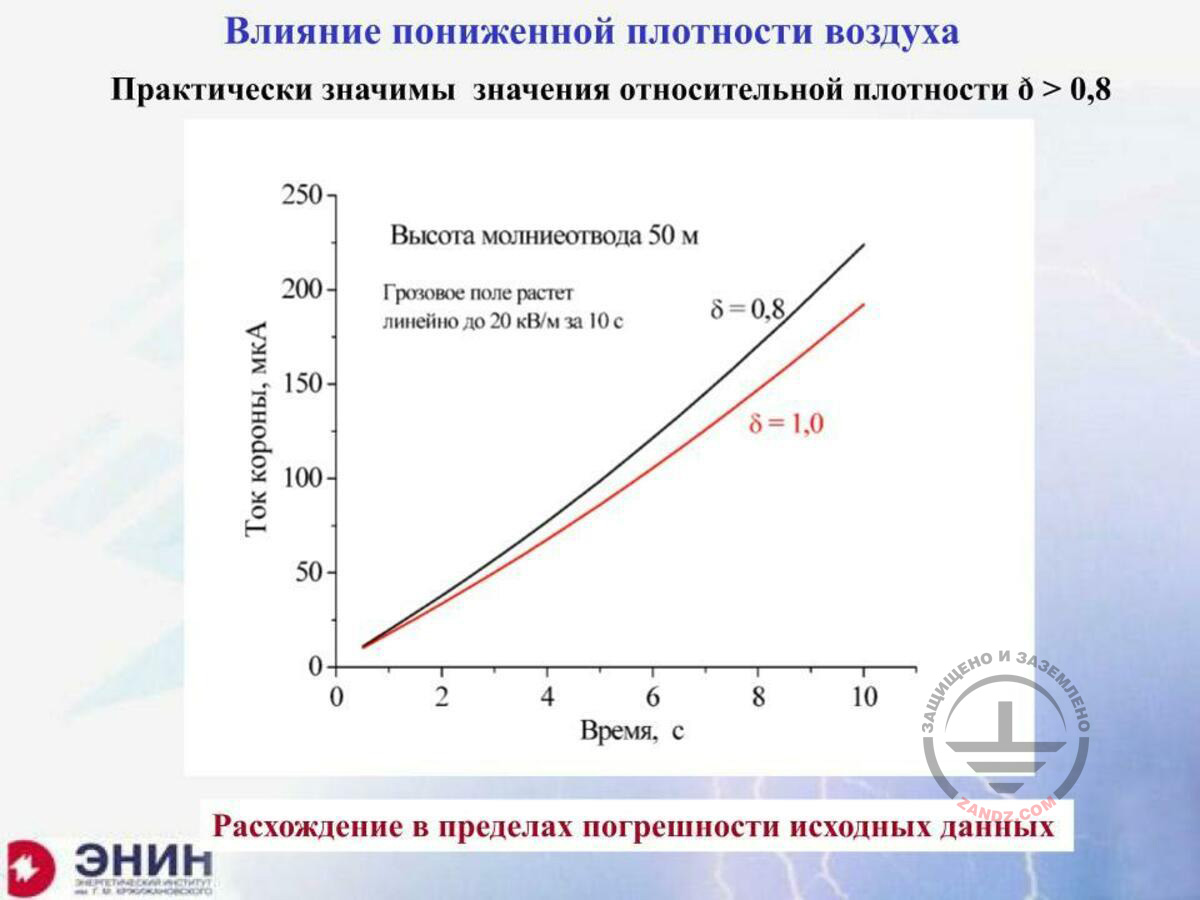
Reduced air density impact
Влияние пониженной плотности воздуха
Практически значимы значения относительной плотности δ > 0,8
Высота молниеотвода 50 м
Грозовое поле растет линейно до 20 кН/м та 10 с
Ток короны, мкА
Время, с
Расхождение в пределах погрешности исходных данных
Reduced air density impact
Relative densities δ > 0.8 are of practical significance
Lightning arrester height 50 m
Storm field grows in a linear fashion up to 20 kN/m for 10 s
Crown current, mcA
Time, s
Difference within the source data error
And now, since we have no other option, let's ignore all regulatory documents and start modelling all these processes to see their important and non-important aspects. We will start with the air density. In general, the air densities less than 0.8 or even 0.7 are hardly worth considering because we are moving to the heights of over two thousand meters above the ground. And this height is not meaningful for the lightning protection because if you do not deal with any unique hotels or residential communities, then usually the facilities such as standard houses, industrial assets, power lines are located lower. So, let's see how the electrical crown characteristics vary when the air density changes. This diagram shows the calculation results. This is a volt-ampere characteristic, crown current vs time, at the height over the sea level equal to 1 with the air density equal to 1, and this means mountains. The difference here is within 10%, and this value can hardly impact significantly the conditions of formation of the opposed discharge and, thus, the number of strikes into the facility. Let's see what happens next.
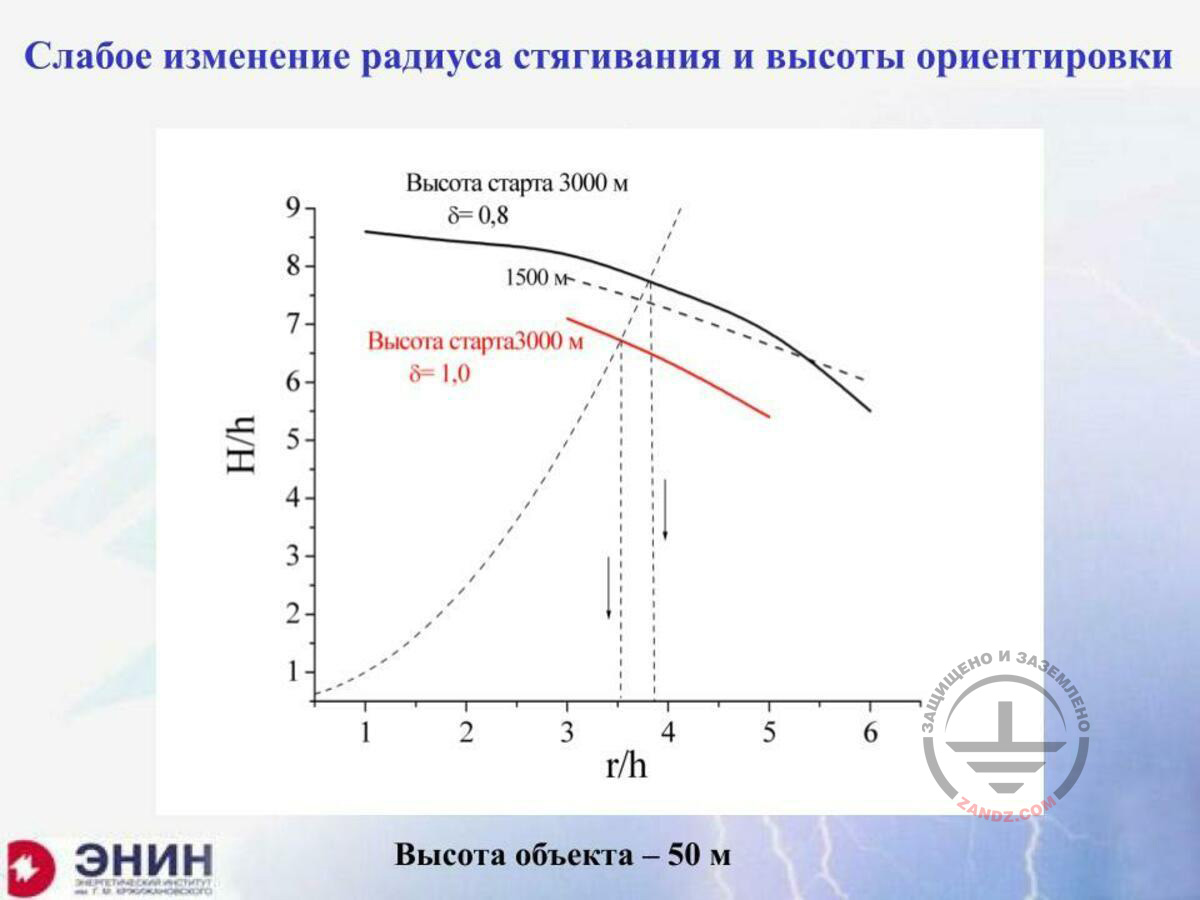
Change in the collection radius and orientation height
Слабое изменение радиуса стягивания и высоты ориентировки
Высота старта 3000 м
Высота объекта – 50 м
Slight change in the collection radius and orientation height
Starting height 3,000 m
Facility height 50 m
Then you may look at how the opposed leader is formed and how the collection radius of the lightning to the facilities is determined in the mountains and at the height above the sea level. These calculations provide the dependence of the orientation height and the radial distance. The black curve represents the reduced air density. The red curve represents the normal air density. And this difference is, again, at a level of 10–15%, and this is the landscape height impact, the air density impact. It is ridiculous to talk about the difference of around several dozens percent in the lightning protection. Is it clear? If the collection radius slightly changes and the orientation height does not almost change, it means that, otherwise being equal, the number of strikes into the facilities at different heights in the mountains and on the plain and due to the air density, I emphasize, due to the air density, they cannot change.
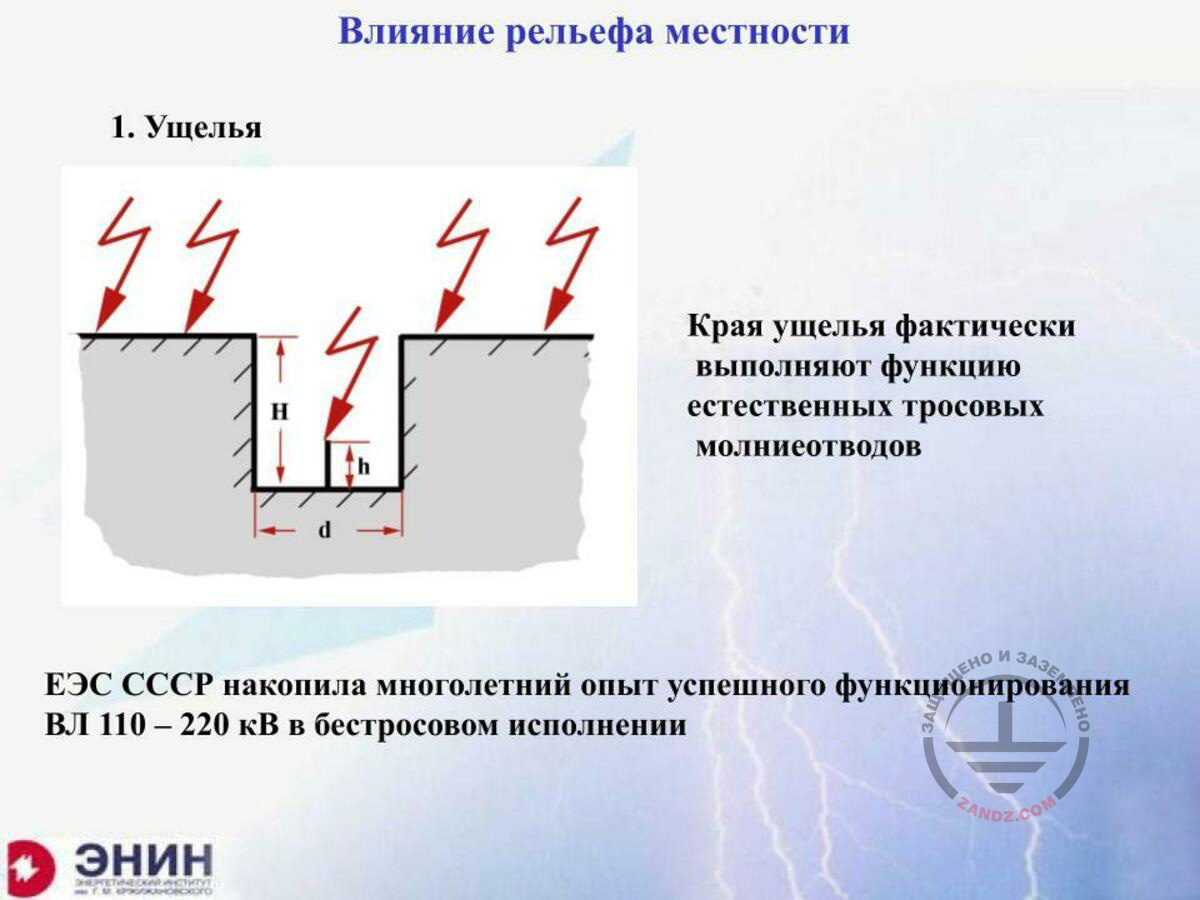
Landscape impact
Влияние рельефа местности
1. Ущелья
Края ущелья фактически выполняют функцию естественных тросовых молниеотводов
ЕЭС СССР накопила многолетний опыт успешного функционирования ВЛ 110 - 220 кВ в бестросовом исполнении
Landscape impact
1. Gorges
The edges of the gorge function as natural wire lightning arresters
The USSR unified energy system has accumulated the rich experience of successful operation of 110–220 kV power lines without wires
The landscape is a different question. The point I have just shown to you in the figure is an exaggerated state of the facility located in the gorge. Here is the facility located in the mountains but in the gorge. The walls of the gorge are around it from the left and from the right. And in fact, the walls of this gorge, for this facility, are something like wire lightning arresters. And if I start calculating wire lightning arresters taking them as a gorge, the situation will be like this: I have a gorge here, and the facility is installed in the gorge that I have to protect, and these gorge walls are generally something like the wire lightning arrester. And if I begin calculating, it will appear that this natural wire lightning arrester, an element of which is constituted by gorge walls, protects the power lines very well. Then, I will show you how good this protection is.
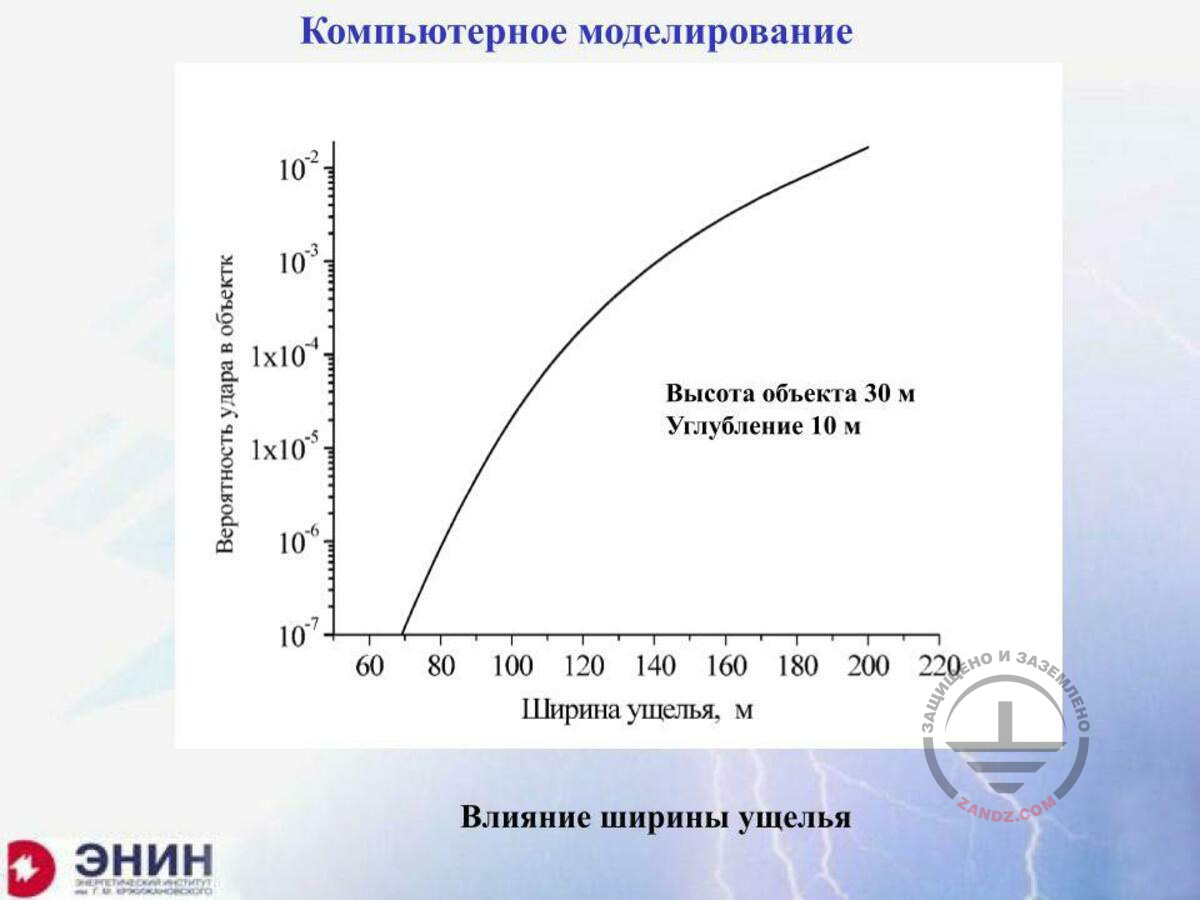
Computer modelling
Компьютерное моделирование
Вероятность удара в объект
Ширина ущелья, м
Влияние ширины ущелья
Высота объекта 30 м
Углубление 10 м
Computer modelling
Probability of the strike into the facility
Gorge width, m
Gorge width impact
Facility height 30 m
Depth 10 m
Look here. The facility height is 30 meters. The gorge is higher than the facility for only 10 meters. Depending on the gorge width, this diagram shows the probability of the lightning strike into the facility. It means that even in case of the gorge of 150 meters high, this protection reliability is at a level of 0.99, the breakthrough probability is at a level of only 10-2, i.e. the gorge walls are a perfect natural lightning arrester. The fact that they are a perfect natural lightning arrester is confirmed by the computational curve shown here. I cannot avoid mentioning some names here. In the former Kyrgyz Republic, our Russian specialist worked who is continuing his work in the presently independent Kyrgyz state; his name is Vladimir Aleksandrovich Mezgin. He has spent many years for studying the protection effects of the power lines located in the gorges. And due to his efforts, in the Soviet time, they managed to authorize construction of such power lines in the gorges without wire lightning protection. Vladimir Aleksandrovich proved that the gorge walls protect these power lines very reliably.
Next page >>
slides from 8 to 14
Related Articles:
 Lightning Protection of Large Territories: Parks, Grounds, Plant Territories. Page 1
Lightning Protection of Large Territories: Parks, Grounds, Plant Territories. Page 1
 Lightning Protection of Large Territories: Parks, Grounds, Plant Territories. Page 2
Lightning Protection of Large Territories: Parks, Grounds, Plant Territories. Page 2
 Lightning Protection of Large Territories: Parks, Grounds, Plant Territories. Page 3
Lightning Protection of Large Territories: Parks, Grounds, Plant Territories. Page 3

